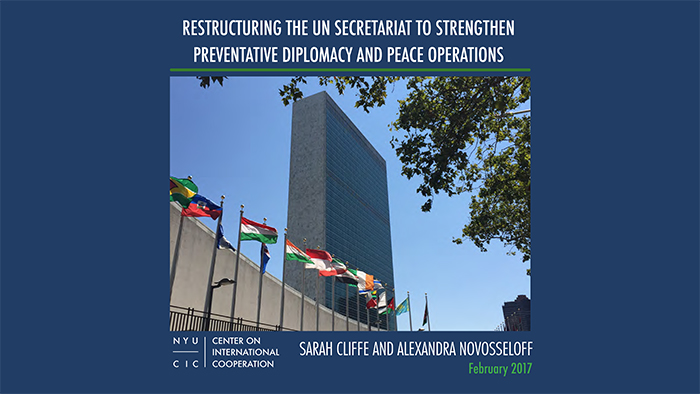The United Nations’ peace and security pillar has prevented the recurrence of conflict and protected civilians in many countries around the world. However, the peace and security architecture now faces deep challenges, with three reviews in 2015 pointing to the need for organizational reform. In one of his first decisions, the new Secretary-General António Gutteres tasked an Internal Review Team (IRT) to make recommendations on organizational change, following the recommendations of the high-level independent panel on peace operations, the advisory group of experts on peacebuilding and the 1325 review. As an interim measure, he gave initial instructions on the co-location of regional groupings of Department of Political Affairs (DPA) and Department of Peacekeeping Operations (DPKO) and the creation of an Executive Committee (EC) in his office.
Against this background, the Center on International Cooperation (CIC) has produced a report entitled “Restructuring the UN Secretariat to Strengthen Preventative Diplomacy and Peace Operations” that analyzes managerial and structural challenges at UN headquarters that reduce performance on the ground, and assesses options for organizational change. On February 21st, the findings of this report were presented by Sarah Cliffe and Alexandra Novosseloff at a recent IPI closed-door roundtable event on “Restructuring the Peace and Security Pillar of the UN Secretariat” held under Chatham house rule.
The report identified that there are many operational challenges of large missions overwhelming a broader “culture of prevention”; the fragmentation of the system and of UN actors into silos, which undermines coherent action; the absence of clear political strategies to guide peace operations and enable sustainable solutions to crises; the lack of authority and resources for peacebuilding; competition between the departments of political affairs and peacekeeping operations; the multiplicity of UN actors and fragmented initiatives for political, security and justice institutional support; and the disconnect between operations and field support.
The paper presents four clusters of options for restructuring: (1) dedicated management options (e.g. second Deputy Secretary-General); (2) fusion models (e.g. merging DPKO/DPA and/or DPKO/DFS); (3) form-follows-function models (e.g. clearly delineating political, operational and “institution building” functions); and (4) peacebuilding options (e.g. integrating peacebuilding more closely with other EOSG cross pillar functions). The authors underlined that no one model is perfect, with competing pros/cons and various levels of political feasibility associated to each. The authors also described the paper’s analysis of budget issues and of practical policy considerations in selecting the most appropriate option.
Participants agreed with the paper’s conclusions that strong leadership and management are key factors to implement reform of the peace and security pillar. The authors noted that, in consultations on the paper, there had been general agreement on this, but that on the other hand when asked whether stronger leadership and management was enough to resolve the problems without organizational change, the clear conclusion was “No. The structures also need to be improved to deliver the functions needed.” Participants further stressed the need to overcome silos and to ensure coherence among departments to bring an end to the competition between the departments of peacekeeping operations, political affairs and field support, in particular; as well as to better link the capacities of agency, funds and programmes with those of the peace and security pillar, as has been done in the global focal point for police, justice and corrections.. The “static” UN work culture and its rigid rules and procedures were also mentioned; participants called for greater flexibility in order to adapt to the realities missions are confronted with on the ground. They stressed the need to rebalance the relationship between the Security Council and the Secretariat and to ensure timely and effective information-sharing.
The responsibility of Member States on the Security Council, particularly the P5, and their relation to the UN Secretariat was also discussed. The Council is often paralyzed and fails to take necessary action because of division amongst its members. This is particularly true in the case when preventative action is required, as was the case in Burundi. Among the participants, there was a broad consensus on the need to shift the UN’s work to more upstream conflict prevention.
Lastly, the need to change the way the budgets are negotiated was strongly acknowledged by all participants, as well as the need for a better strategic discussion between the Secretariat and the members of the Fifth Committee prior to the negotiations. The strategic budget analysis in the report was noted as useful, and participants felt that this type of more strategic-level analysis is urgently needed for the next budget discussions.
Participants welcomed strong leadership and direction from the office of the Secretary General and encouraged the work of the Internal Review Team (IRT) on the Secretariat’s Peace and Security Architecture due to report in June 2017. They however cautioned that reform will require the sustained support from a broad range of Member States at a time when there is pressure for budget reductions from major financial contributors.
The roundtable event was moderated by Arthur Boutellis, Director of the IPI Brian Urquhart Center for Peace Operations.








